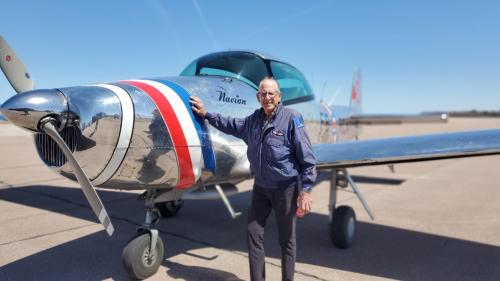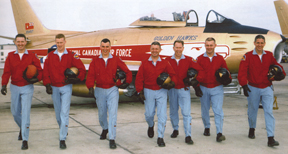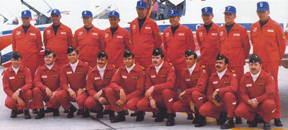George Miller
Shane Fowler of CBC News posted this report on May 19, 2022
87-year-old pilot ends elite flying career with cross-country flight to New Brunswick.
George Miller's 68-year career at the controls ended at the airport that started it all.
Roaring by the eastern New Brunswick airport under a blazing sun, the Navion's unpainted silver fuselage reflected so much sunlight it stung the eyes. The plane has a 1950s sci-fi movie spaceship vibe, from back when the future was made of chrome. Aircraft fanatics would recognize its fighter plane lineage. Designed by the same company that built the legendary Second World War P-51 Mustang, the Navion emits a throaty growl as it flies by.
They don't make planes like this anymore. And on this spring afternoon, the Navion came out of the sky for the last time, touching down at the Miramichi-Chatham Airport.

George Miller and his immaculate Ryan Navion.
"I just love that airplane," said George Miller. "And I know that it'll be hard to finally take the last look at it." After spending 68 years in the air, George Miller is saying goodbye to flying and goodbye to his Navion, flying it across Canada to donate it to a New Brunswick museum.
Born on Fogo Island off Newfoundland's north shore in 1935, Miller recalls being enraptured by a float plane delivering supplies to the island when he was just six years old. On his 18th birthday, he signed up with the RCAF. For the next 35 years he was a fighter pilot. And it was this little New Brunswick airport that gave him his start.
In his early air force days, Miller says the first transonic fighter jets, planes capable of flying as fast as the sound barrier, were just coming into service. He put in a request to be trained to fly them. To this day, he still can't believe it was granted. Miller moved to New Brunswick and started training to fly CF-86 Sabre fighter planes, an aircraft first flown against Russian MiGs in the Korean War.
The airport was a military hub then, much bigger than the humble airstrip it is today. "This was our major, major fighter base, like Cold Lake is right now in Alberta," said Miller. Miller's first tour in 1955 was flying Sabres in Germany in the early years of the Cold War.
"Basically, that was to counter the impending Russian threat because the Russians … they really had plans on moving into Europe and the threat was real," said Miller. "And then, of course, we'd be in the Third World War."
He eventually upgraded to the Canadair CF-104 Starfighter, a jet capable of flying at twice the speed of sound. It was also capable of nuclear strikes, carrying US-supplied nuclear weapons. After piloting the Starfighters in Germany, Miller was transferred to Sardinia, Italy where he trained Canadian pilots on transporting and deploying nuclear weapons.
He also spent time in the 1970s in Kingston, Ont., as the director of the Air Force Staff College, and then was sent to Egypt when that country was entering into peace talks with Israel. "That was an amazing time in my career … and they gave me one year of intensive Arabic language training, so I became bilingual in Arabic … and I had some crazy missions across the 'no man's land.'
Miller was also part of both of Canada's high-flying air force stunt squads. His talent flying those first Sabres landed him a spot on the 1962 Golden Hawks squad. The Golden Hawks would showcase high-speed manoeuvres and stunts at airshows, wowing crowds across the country. In 1973, he went to Moose Jaw, Sask., to help fashion the newly formed Snowbirds flight squadron into a national aerobatic team.
Miller eventually formed his own flying aerobatic team after retirement, the Fraser Blues, flying alongside his son, putting on shows throughout British Columbia.
Pilot George Miller showed off his Ryan Navion before donating it to the New Brunswick Aviation Museum. Miller's plane for those shows was the Navion. But despite still being in excellent health, this was the year to give up flying, he said. "I feel very capable of flying, there's no problem there," he said. "But I think it's good to be sensible.
Kevin Anderson, executive director and the founder of the New Brunswick Aviation Museum, is grateful for Miller's donated plane. "Well, I had a pretty big smile on, I'll say that much," said Anderson. "The reason that it was important for us to get it is that with the Golden Hawks being formed here in 1959 they were a huge part of Canada's aerobatic team history," said Anderson.
Miller decided to deliver the Navion to New Brunswick himself, making the final flight from his home in Langley, B.C. On May 1, as he was going to bed, he checked the weather on his phone. He was shocked to find the perfect tailwind flowing across Canada. "I couldn't believe it," said Miller. "It was from coast to coast. This was a Sunday, and I said, 'I'm leaving Monday,' and I did."
The perfect co-pilot.
But at 87, Miller knew he couldn't complete the trip alone. With any older plane, maintenance and upkeep is a constant variable, so he'd need someone who wasn't just along for the ride.
He chose 27-year-old engineer Freya Inkster. "She's an absolutely wonderful maintenance engineer," said Miller. A pilot herself, she maintains about 30 to 40 airplanes, including Miller's, and said she was honoured when he asked her to help him make his final flight. Freya Inkster has been the Navion's maintenance engineer in Langley, B.C., for years.
About halfway through the trip the Navion started having engine troubles and had to land in Kenora, Ont. She ended up having to replace a cylinder, shipping in a rebuilt one they luckily had back in Langley. The rest of the flight went by without incident.
After nearly seven decades of flying, Miller descended out of the sky for the final time. To his surprise, two fire trucks arched streams of water across the runway as a welcome. After an emotional hug with Anderson, Miller handed him the keys to his plane. "An end of an era, that's for sure," said Miller.
Shane Fowler · CBC News · Posted: May 19, 2022
George Miller and the Snowbirds

George Miller (right) with the Golden Hawks, 1962
The base commander of RCAF Moose Jaw, Colonel Philp began to search for a new aerobatic team leader, and knew exactly what he was looking for - another veteran pilot with a strong fighter background (and preferably aerobatic team experience) to take the Snowbirds to the next logical step - full aerobatic status. He knew most of the majors in the air force with suitable qualifications but wanted another opinion from a respected ally. He called on Major C.B. Lang for his thoughts. In reviewing the list of possible candidates, both came up with the same name - Major George Miller. A former solo with the Golden Hawks, Miller was highly regarded in the CF-104 community where he was employed at the time. Therein lay the problem - he had not been in the European theatre long and pulling him off of a highly sought after tour might be difficult. However, this turned out to be inconsequential as Colonel Philp was able to spring Miller with a phone call to the Commander. As for George Miller, he leapt at the opportunity and picks up the Snowbird story:
“I often recall the 1973 Snowbird experience and the thrill and challenge, as a team, of preparing a nine-plane display in a time span of seven weeks, that is from first pilots’ meeting to our first show. I arrived at Moose Jaw on March 12, 1973 having accepted the very honoured position of team lead a week prior in Germany via a conference call led by Snowbirds’ founder, Colonel O.B. Philp. From the moment I arrived, O.B., as base commander, offered the support, ‘open door’ and independence I needed to cover ground quickly. I still remember our first meeting in Moose Jaw which he summed up by saying, “Your first show is in Yellowknife on May 15. I don’t care if it’s a four or nine-plane and the speed you develop is up to you. Keep it safe and just let me know when you’re ready to show me something and I’ll be your eyes from the ground.” And that he was, and his observations proved a tremendous help and incentive to us as we cut corners to form and develop quickly.”
“Having never flown the Tutor aircraft, I had to quickly ‘check out’ and start flying with selected team members immediately. The eight pilots joining me were the best of the instructional staff that had volunteered. We wasted absolutely no time. I decided to assign team positions based on one interview, one formation trip and intuition. With exhaustive briefings and debriefings and all of us fully focused in max learn mode, we cut directly to four-plane formation and solo work at 500 feet. Every day was a three trip day if the weather allowed it. I quickly found we had strength everywhere. At the difficult outer left wing, Capt Bob Wade’s skill enabled us to rapidly develop the line-abreast work. Our two solos, Capts ‘Inch’ Illingworth and Tom Griffis, began building a safe but aggressive routine with no obvious sign of being tentative in the wake of the previous year’s solo fatality. I had no cause to develop any real concern.”
“We tried a lot of original stuff as our 25 minute routine developed and as we worked on whittling our ‘off stage’ time down to 10 seconds. We faced few restrictions and I imposed none outside acceptable boundaries of team discipline and safety. Organization of the season schedule and selection of showsites and promotion was done by the team. The going was not easy as we were so short staffed with so little time to organize the team and schedule from scratch. Evenings were spent on the telephone coordinating promotion and showsites. All of our team flight suits and social attire was voluntarily paid for by the pilots and groundcrew, as was a lot of our promotional material. O.B. provided great base commander support in the provision of assigned groundcrew and the dedication of rapid base response to team needs whenever required. He also provided financial support as best he could. His advice, moral support and his actions as intermediary with headquarters were invaluable.”
“Within a few weeks of our first show, 2 CFFTS adjusted its afternoon schedule to allow us to practice over base. This provided the valuable audience reaction and critique together with O.B.’s comments. I chose the nine-plane double loop entry with solo splits to open the show and chose a show ‘action’ highlight to close it. This involved putting three simultaneous manoeuvres on stage as part of the landing sequence that allowed a four-plane box landing followed immediately by the rest in trail. We included a four-plane loop to downwind, a three-plane roll-around break and solos’ low-level tuck-under break, all at the same time. It proved to be a real crowd pleaser.”

George Miller (front centre) with the Snowbirds, 1974
“Our opening show at Yellowknife went very well. It was the first of 38 in 1973, seven of which were in the United States. This took the team from coast to coast twice. The revival of a full aerobatic display team representing the air force, the Canadian Forces and indeed Canada, evoked a great response wherever we performed. On July 14, 1973, Capt Carl Stef had to eject from his aircraft following an engine compressor stall due to a bird strike. Due to the subsequent back injuries he received from a very hard parachute landing, he was unable to return to the team until September. To the team’s credit, it was able to modify its formations within a few days and carry on as an eight-plane team until Carl’s return. I was extremely proud of the 1973 team and how well it rose to the challenge in such a short time frame and under considerable financial and administrative restraints. It launched initiatives in every area of team operations and support and established standards and procedures that would enable the growth of a national team to achieve the vision foreseen by Col O.B. Philp in getting it all started a few years prior.” George Miller
For more on the Snowbird story see A Tradition of Excellence written by Dan Dempsey.